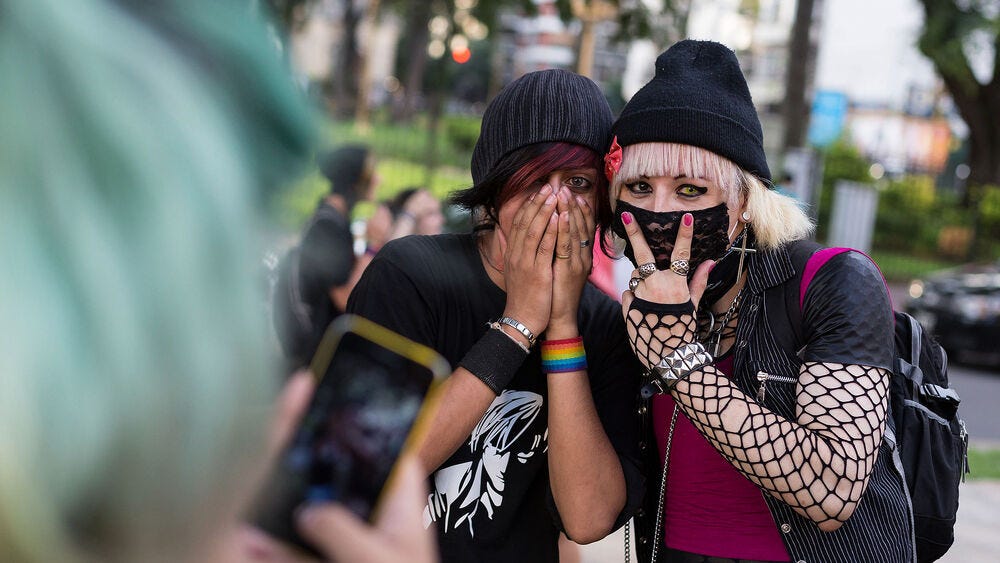Fotolog, Floggers and the aesthetics of platforms
Further comments on my interview with Amalia Ulman
I just released an interview with the pioneering net artist and director Amalia Ulman. You may be familiar with one of her most well-known performances, “Excellences and Perfections”, which was a 4-month long durational Instagram performance in which Amalia staged the life of a fictional influencer across three aesthetic arcs: kawaii girl, influencer baddie, and hippie wellness devotee. All under the watchful eyes of her growing follower count.
Amalia, through her work, uncovers the aesthetic archetypes that are so pervasive on our social media platforms. In the interview, we focused on Fotolog, an image-sharing platform founded in 2002, that served as the breeding ground for a lot of alternative subcultures in South America. Amalia wrote a great essay in 2012 on the topic.
Excellences & Perfections expounds abstractly on commodification of aesthetics. Through the personification, for a few weeks at a time, of three archetypes, Amalia Ulman demonstrates that certain lifestyles are essentially represented only through aesthetics and images and how that provides them an uncomfortable proximity to fiction, and that there is a fundamental difference between the life we live and the life we portray in images.
Today, this feels almost self-evident. But it’s important to remember that Excellences & Perfections was performed in 2014, over a decade ago, at a time when we had not yet reached these same conclusions about the nature of digital life and representation.
What’s particularly notable is the rapidity and fluidity with which Ulman was able to embody these archetypes. The performance lasted just four months—not four years. You could move rapidly through different personality types and lifestyles, simply through the mechanisms of image production. While the labor behind these images often remains invisible, it is still clear how relatively easy it is to adopt these commodified, highly recognizable aesthetic templates.
An interesting insight from the conversation. These archetypes are influenced not only by culture but also by the platform. Fotolog had a few distinctive platform constraints—users could post only one image per day, and there was a limit on the number of comments—which shaped a slightly different relationship to self-presentation than what we now see on Instagram.
The first group was the “Pokemónes” in Chile. Best understood as hybridization of otaku sensibilities, punk politics and Emo hairstyles, the Pokemónes utilized Fotolog as a place to share their outfits and meet one another.
The second group were Floggers.
Known for their scene style, bright-colored clothes, emo haircuts, skinny jeans and eclectic accessories, the Floggers are directly intertwined, as their name may suggest, with the platform Fotolog. The medium and the affordance of image-sharing led to its growing popularity, as Floggers adopted the platform as their digital home-turf.
However, as much as platform-based aesthetics benefit from the correlation with a platform’s growth and network effects, so too do they enjoy the downsides. Agustina Villera, known online as Cumbio or “La Reina de los Floggers” (“The Queen of the Floggers”), the group’s informal leader wrote in 2011 about the movement, “The climax was in 2009. But Facebook had a lot of influence on the fashion disappearing. Also, Fotolog became very commercial and now they charge you for everything. Sometimes I see photos from when I was a flogger and I wonder, was this what I used? It looked like a massacre!”
Cumbio’s quote reminds me of the Shock of Alteration which I explored in my book “A Cyberarchaeology of Checkpoints.”
The “Shock of Alteration”: the feeling of confusion that occurs after a notable change is pushed to an interface. You wake up, you discover that your favorite platform has deployed an automatic and mandatory update, and nothing is the same.
Over time, however, there was a convergence toward a more homogenized, highbrow visual culture on Fotolog. Evidently distinct subcultures and aesthetics grew out of Fotolog—namely the Floggers and the Cumbieros. The Floggers represented a more polished, unified, upper-middle-class aesthetic, a more Eurocentric sensibility, while the Cumbieros, at the margins, developed a much more punk, queer, DIY aesthetic. In response to this divergence, the Cumbieros, the users from working-class backgrounds, built their own platform: Fotocumbia.
Fotocumbia represents a radical act of technological and aesthetic sovereignty. Rather than simply pushing back within the enclosure of Fotolog, users aligned with Cumbia Villera culture created an entirely new network where their working-class aesthetics could converge on their own terms. Instead of aspiring upward to the dominant aesthetic, they generated an alternative grounded in their own reality through technology.
When we consider this in the context of today’s internet, it feels all the more inspiring. We know there is now an "Instagram face," to borrow Jia Tolentino’s term, we can perceive the aesthetic convergence. Yet despite widespread dissatisfaction, we rarely imagine building our own platforms to counter it. Fotocumbia remains an extraordinary example of what it looks like when users refuse to accept dominant visual regimes—and create spaces of their own.
What does an image-sharing platform for your own subculture look like? Why aren’t we building it, now?







